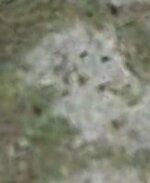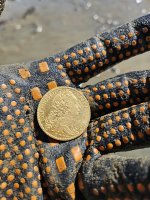lokiblossom
Bronze Member
My purpose with providing this theory is to garner support (not funds) for investigating the actual location of this treasure. A site that I have already recently visited. I don't believe this violates the rules of the forum, but will stand down if asked to by the forum moderators. While starting at what I call the beginning, I will add more information as time permits.
Part I,
Troyes France 1099: The Holy Land (Palestine) had just been won through the results of the 1st Crusade, and in Troyes The Count of Champagne, Hugh I, who preferred the Title Count of Troyes kept a keen eye to the events unfolding there. He had already heard from the local Rabbi called Rashi about the Ark of the Covenant which had been hidden below the first Temple built by Solomon. It is well known that most Rabbis of the period felt that the Ark was indeed in caverns below the Old Temple.
At the same time it was also well known that the Church was on the hunt for religious relics that could help prove the story of Christianity to their congregations.
Rashi was very famous in Troyes in the very early 12th century as well as in the Court of Champagne located in Troyes. Evidently using information learned from Rashi (who died in 1105) Count Hugh and his Vassel Hughes de Payens went to the Holy Land in 1104. Returning to Troyes in 1108 the two men then founded an order of Knights called "La Milice of Christ", which had as its main objective to uncover religious relics from the area of the Old Temple of Solomon, at this time the location of the Dome of the Rock.
In about 1113 a little known monk named Bernard along with some thirty men from Burgundy (mostly his own relatives) joined the new Cistercian Order at Citeaux Abbey near Dijon. In 1115 Bernard received donated lands from Hugh I for a new abbey at Claire Vallee, or Clairvaux, near Troyes and from then on he is to be known as Bernard of Clairvaux. From this point on Bernard becomes the main campaigner for the, La Milice of Christ.
By 1118 this new supposed military order has nine members, all relatives of Count Hugh and or Hughes de Payens and has adopted the official name of "The Poor Knights of Christ and the Temple of Solomon", or more simply "Knights Templar" with de Payens as its first Grand Master. As they have been for a few years already this group of Knights continues to excavate under the Temple area and also throughout Jerusalem for highly sought after Christian religious objects. Although we only have the names of eight of these first Templars, it is almost certain that Count Hugh is the ninth member but remains unnamed as such.
This excavation being undertaken at the old Temple Mount is well documented, but what was actually found there (if anything) is open to much conjecture.
It is my opinion that if anything had been found that would help to prove the position and doctrine of the Church it would have been immediately turned over by this staunch Catholic Order.
But what if they had found something from the still existing Christian Church of Jerusalem, the Church that was originally headed by the brother of Jesus, James, that they believed went against the then current orthodoxy?
It is certain whatever it was would be taken back to Troyes and for at least the near future been housed at The Court Of Champagne.
From this humble beginning the Knights Templar Order blossoms into a powerful military organization and begins to actually carry out the original stated purpose of their mission, the protection of pilgrims visiting the Holy Land. Also becoming at the same time very wealthy, a trend that would continue for most of the rest of their existence.
In Troyes a few years later a story is told of brave Knights searching for an object eventually referred to as "The Holy Grail".
In 1181 Chretien de Troyes (Chretien of Troyes), a poet who served his patron Marie, Countess of Champagne, was requested by her to write a romance, concerning a sacred object called the "Grail" with brave Knights searching for it, a romance he called "Perceval, the story of the Grail". Although unfinished by Chretien, another did complete the story, Robert de Boron. de Boron connected this Grail to the Christian story calling it "The Holy Grail" and identified the Knights as Templars. It is for certain that in this part of the story, what I call the Troyes connection cannot be overestimated. de Boron, also mentioned a Grail mountain where the Holy Grail was hidden called, "Montsalvat", an obvious connection to a Mountain in the Languedoc area of France named Montsegur, As discussed by the man many call the original Indiana Jones, Otto Rahn. Rahn believed that the Holy Grail had been hid in the Sacred mountain by the Cathar's in the early 13th century. I will discuss both Rahn and the Cathar's relations to my theory a little later. End of part I
cheers, Loki
Part I,
Troyes France 1099: The Holy Land (Palestine) had just been won through the results of the 1st Crusade, and in Troyes The Count of Champagne, Hugh I, who preferred the Title Count of Troyes kept a keen eye to the events unfolding there. He had already heard from the local Rabbi called Rashi about the Ark of the Covenant which had been hidden below the first Temple built by Solomon. It is well known that most Rabbis of the period felt that the Ark was indeed in caverns below the Old Temple.
At the same time it was also well known that the Church was on the hunt for religious relics that could help prove the story of Christianity to their congregations.
Rashi was very famous in Troyes in the very early 12th century as well as in the Court of Champagne located in Troyes. Evidently using information learned from Rashi (who died in 1105) Count Hugh and his Vassel Hughes de Payens went to the Holy Land in 1104. Returning to Troyes in 1108 the two men then founded an order of Knights called "La Milice of Christ", which had as its main objective to uncover religious relics from the area of the Old Temple of Solomon, at this time the location of the Dome of the Rock.
In about 1113 a little known monk named Bernard along with some thirty men from Burgundy (mostly his own relatives) joined the new Cistercian Order at Citeaux Abbey near Dijon. In 1115 Bernard received donated lands from Hugh I for a new abbey at Claire Vallee, or Clairvaux, near Troyes and from then on he is to be known as Bernard of Clairvaux. From this point on Bernard becomes the main campaigner for the, La Milice of Christ.
By 1118 this new supposed military order has nine members, all relatives of Count Hugh and or Hughes de Payens and has adopted the official name of "The Poor Knights of Christ and the Temple of Solomon", or more simply "Knights Templar" with de Payens as its first Grand Master. As they have been for a few years already this group of Knights continues to excavate under the Temple area and also throughout Jerusalem for highly sought after Christian religious objects. Although we only have the names of eight of these first Templars, it is almost certain that Count Hugh is the ninth member but remains unnamed as such.
This excavation being undertaken at the old Temple Mount is well documented, but what was actually found there (if anything) is open to much conjecture.
It is my opinion that if anything had been found that would help to prove the position and doctrine of the Church it would have been immediately turned over by this staunch Catholic Order.
But what if they had found something from the still existing Christian Church of Jerusalem, the Church that was originally headed by the brother of Jesus, James, that they believed went against the then current orthodoxy?
It is certain whatever it was would be taken back to Troyes and for at least the near future been housed at The Court Of Champagne.
From this humble beginning the Knights Templar Order blossoms into a powerful military organization and begins to actually carry out the original stated purpose of their mission, the protection of pilgrims visiting the Holy Land. Also becoming at the same time very wealthy, a trend that would continue for most of the rest of their existence.
In Troyes a few years later a story is told of brave Knights searching for an object eventually referred to as "The Holy Grail".
In 1181 Chretien de Troyes (Chretien of Troyes), a poet who served his patron Marie, Countess of Champagne, was requested by her to write a romance, concerning a sacred object called the "Grail" with brave Knights searching for it, a romance he called "Perceval, the story of the Grail". Although unfinished by Chretien, another did complete the story, Robert de Boron. de Boron connected this Grail to the Christian story calling it "The Holy Grail" and identified the Knights as Templars. It is for certain that in this part of the story, what I call the Troyes connection cannot be overestimated. de Boron, also mentioned a Grail mountain where the Holy Grail was hidden called, "Montsalvat", an obvious connection to a Mountain in the Languedoc area of France named Montsegur, As discussed by the man many call the original Indiana Jones, Otto Rahn. Rahn believed that the Holy Grail had been hid in the Sacred mountain by the Cathar's in the early 13th century. I will discuss both Rahn and the Cathar's relations to my theory a little later. End of part I
cheers, Loki
Amazon Forum Fav 👍
Last edited:





